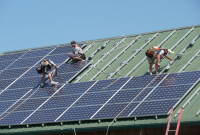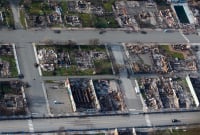Support strong Canadian climate journalism for 2025
It all started with a pipeline.
Twelve years ago, 16 B.C. First Nations came together to purchase an equity stake in the Pacific Trail Pipeline. The pipe was set to weave through ecologically sensitive rivers, lakes and valleys that the nations had stewarded for millennia prior to contact. The proposed project would have pumped one billion cubic feet per day of gas from the province’s interior of Summit Lake to the Pacific Ocean in the port of Kitimat, British Columbia.
When those 16 nations went to the bank for financing, they were told there was no point in trying. The interest rates would be at credit card rates, and the interest payments would outstrip any economic returns. Instead of equity ownership, the nations had to take a cash option from the pipeline deal, sacrificing a steady revenue source for the buyout.
Enbridge, the multinational energy giant, ended up purchasing the Pacific Trail Pipeline in late 2021 from its original owners, Chevron and Woodside. The purchase once again left First Nations watching as industry players profit off another major project that could run through their territories. It’s a familiar story: “Industry has been picking us apart,” Stan Houle, Chief of Whitefish Lake, says of legacy oil and gas companies in Alberta.
That failed purchase was the genesis of the First Nations Major Projects Coalition (FNMPC), Sharleen Gale and Niilo Edwards, the chair and the chief executive officer of the FNMPC, tell Canada's National Observer. Many of those nations went on to push for access to financing capital to enter the resource economy that they had been excluded from since even before Confederation.

A decade later, the FNMPC has won a huge victory. The federal Indigenous loan guarantee program, announced in Budget 2024, opens up $5 billion in loan backstops for First Nation energy and natural resource projects, from pipelines and mines to solar parks and wind farms. The program, the brainchild of the FNMPC and other Indigenous leaders, ensures that interest rates remain as low as possible through Ottawa’s high credit rating, effectively giving Indigenous nations the borrowing power of a Western nation-state. Many First Nation leaders say the amount earmarked is nowhere near high enough but acknowledge that it’s a start.
There’s a lot at stake: over the next decade, Canada will see around 470 natural resource projects, both conventional and “clean economy”–related, developed at a cost of nearly $525 billion, according to the FNMPC. The energy sector alone will hover around 300 projects priced at $450 billion, by far the lion’s share of capital. For First Nations, it amounts to more than $40 billion in opportunities for Indigenous equity participation and stable revenue to develop their communities.
If money is power, then First Nations in the 21st century are slowly building power in Canada’s energy economy. But is there a hidden cost? The federal Indigenous loan guarantee program will be “sector agnostic,” meaning there are no green strings attached to possible projects, leaving First Nations pursuing clean energy mega-projects to compete with oil and gas development. The program stands in contrast to the Canada Infrastructure Bank’s Indigenous Equity Initiative, released last year, which opens up a billion dollars’ worth of loans for clean power, transit and other low-carbon projects with Indigenous participation.
For Edwards, the new loan guarantee is about the self-determination for FNMPC members to conduct business on their terms based on their own assessed risk tolerance for projects. “Whether it’s a solar farm or LNG pipeline, we’re there to support them,” he says.
But another threat looms over the investments supported by the loan guarantee: the climate crisis. How stable are investments in certain sectors as global warming boils the planet, drags out severe drought and sparks catastrophic wildfires?
In the face of the climate emergency and under pressure from environmentalists, Ottawa has committed itself to ending billions in fossil fuel subsidies – but one of the back doors it left open was Indigenous economic participation in the fossil fuel industry.
Now, up to $5 billion in federal, plus billions in provincial, guarantees are available for oil and gas development. It’s happening while the world is set to blast past 1.5°C of warming, triggering catastrophic tipping points. Those current climate projections prompted world leaders at the last UN climate summit, COP28 in Dubai, to agree to “transitioning away from fossil fuels in energy systems, in a just, orderly and equitable manner” to avoid the worst of climate change.
In pursuit of that equitable transition, some First Nations are looking to tap oil and gas development before it sunsets, hoping to finally convert natural resources into prosperity for their communities.
Bound for Bay Street
From the Bay Street underground tunnel in Toronto, it is a short walk through the Zellers section of the Hudson’s Bay store, past the Jamaican patty and noodle shops and shuttered fast-food stands, to reach the Sheraton conference centre.
A decade after the failed pipeline purchase, the FNMPC has set a meeting ground for First Nation leaders and Canada’s elite to network. Leaders of industry and current and former ministers from the provinces and Parliament Hill flocked to the FNMPC’s conference in April to exchange cards, share meals and shake hands.
Bay Street, not Ottawa, may soon become the central focus for First Nations seeking to develop their lands and resources. In turn, industry can now seek equity partnerships to expedite projects and avoid the risk of First Nation opposition within lengthy court and media battles.
On day two of the conference, Finance Minister Chrystia Freeland acknowledged how the loan guarantee can be an engine to hasten industrial development: “The world needs us to get more major projects built, to do them better and to do them faster,” she told the conference attendees. And it’s “Indigenous participation” that gives her confidence that Canada will achieve those aims, she explained to applause.
In the era of the United Nations Declaration on the Rights of Indigenous Peoples (UNDRIP), the definition of the phrase “free, prior and informed consent” is still a battleground. The federal act that enshrined UNDRIP did not allow for veto power but instead more rigorous consultation. Equity partnerships may provide a solution for that struggle through a commitment to economic justice between the Crown, industry and Indigenous nations in future extraction of the land’s resources.
For the FNMPC, that equity should come as broadly as possible – including through the inclusion of Indigenous communities in the development of a greener grid that enables Canada to reach net-zero.
“Equity ownership in projects is the greatest example of consent,” says Perry Bellegarde, former national chief of the Assembly of First Nations.
Bellegarde’s argument for Indigenous inclusion relies on the increased decision-making and monitoring that Indigenous-staked ownership can provide. Instead of a consultation at the environmental assessment stage, equity ownership allows for a voice throughout the life of a project to balance economic development and environmental stewardship, Bellegarde explains.
“With every opportunity comes greater responsibility to make better decisions to protect the land and waters for future generations,” he adds. “We have this great opportunity. But man, there’s a big load of responsibility now [to make] sure we don’t screw it up.”

Chasing the last oil boom
There was a time when prospective oil and gas barons flocked to Calgary – transforming Alberta’s Bible Belt legacy into a land of tar and honey. From the 1970s oil boom, more millionaires were made in Calgary than at any time before in Canadian history.
It was around that era, and in the decades after, that some First Nations began negotiating stronger revenue-sharing agreements. Maskwacis, for example, secured deep pockets in the 1970s and onwards by increasing revenue sharing from 10% to 40% for oil and 70% for gas revenues from on-reserve drilling, creating hundreds of millions of dollars of wealth for future generations.
But not all First Nations struck black gold on the reserves that Ottawa confined them to.
A tailor and laundromat for Suncor was the extent of Whitefish Lake First Nation’s participation in the oil and gas industry. For more than 40 years, Whitefish Lake has owned a dry-cleaning and a fire-retardant-coverall-making company that employ around 200 band members, Chief Houle says. Meanwhile, Suncor raked in almost $23 billion in profits last year alone.
“It’s been pretty grim in Alberta,” Houle says about revenue-sharing prospects from the oil and gas industry. “We’ve been working for our money.”
Now, First Nations in the province are finally seeing profits from their lands flow into their communities. Whitefish Lake is a success story of Alberta’s loan guarantee program, which Ottawa modelled its program after. Whitefish Lake is now involved in four of the seven projects backstopped by Alberta’s loan guarantee program, all oil- and gas-related, including the new $1.5-billion Cascade gas plant.
Whitefish Lake is growing exponentially. Fifteen years ago, its hockey arena burned down, but now it’s being rebuilt as a community multiplex, containing offices, a community hall, a pharmacy and a barbershop, partly thanks to the increased revenue from the deals. The First Nation also purchased land near its reserve with the profits made from equity stakes – land that is three times the current size of the First Nation, which will house future band members as the community grows.
“When I heard the feds are going to do this, well, it’s about time,” Houle says, speaking to a desire for all First Nations to experience the economic development that Whitefish Lake has reached through Alberta’s program.
But this didn’t come easy. Whitefish and similar nations are finding economic justice because they started “doing their homework” by mapping their traditional lands used for hunting, fishing and harvesting. They also started saying no to projects, Houle explains. “When we started doing that, then started winning in courts, well, they realized we should be owners also,” he says.
With oil and profits in the province, Houle thinks Alberta nations should all be living the good life, not “living poor with poor housing, no water, no paved roads when they’re making trillions of dollars off the industry.” It’s why he’s advocating for an oil tax levy, somewhere between 50 cents and a dollar per barrel, for all First Nations in Alberta to syphon some millions of revenues from the ballooned profits of industry. Current oil prices hover over $80 a barrel.
However, time is ticking on the oil and gas era. It’s still unclear how fast the market will collapse as countries transition to renewables or other forms of energy. The International Energy Agency (IEA) has projected that global oil demand will enter long-term decline before the end of the decade. Gas demand is set to peak in 2030 in all scenarios, the IEA has said, raising the thorny question of when new investments in oil and gas will become stranded assets.
That’s why Julia Levin, associate director of Environmental Defence, is wary of the federal government’s “sector-agnostic” loan guarantee. She has concerns that the industry may try to offload stranded-asset liabilities and costs onto First Nations as they seek to share the massive decommissioning costs for fossil projects. “Because of the likelihood of fossil fuel projects becoming stranded assets, fossil fuel companies are looking for a way to dump liabilities and costs onto nations,” she says.
It’s a concern that was raised by the Union of British Columbia Indian Chiefs (UBCIC) regarding the Trans Mountain expansion (TMX) pipeline, a contentious and beleaguered project that encountered fierce opposition from First Nations and environmental groups. The federal government purchased the pipeline from Kinder Morgan in 2018 at a cost of $4.4 billion. With oil now starting to flow, and project costs ballooning to $34 billion, the government has sought to offload the expensive piece of infrastructure. Western First Nations are hoping to purchase an equity stake to fund economic and cultural development, despite warnings from UBCIC that the pipeline risked becoming a stranded asset.
“We are concerned that the government is using TMX as another divide and conquer project and is not providing a full and accurate account of the financial future of the project,” UBCIC said in a 2022 open letter.
It’s still unclear how quickly Alberta will seek to transition its energy mix. Currently, around two-thirds of electricity is produced by “natural gas” (which is largely made up of methane, a potent greenhouse gas). By 2035, projections put the electricity made by gas plants at around 40% to 50%, with the rest produced by renewables, says Jason Wang, senior electricity-grid analyst for the Pembina Institute.
Wang notes that the province’s new gas plants, which run more efficiently than the old fleet, still need to develop greenhouse gas abatement strategies, like carbon capture, to avoid cementing Canada’s dependency on emissions-intensive electricity and turning new gas plants into stranded assets. But carbon capture remains unproven and expensive – a $2.4-billion carbon capture project at an Alberta gas-fired plant was cancelled in May because of costs. These plants will need to develop plans to meet Alberta’s net-zero grid targets by 2050 given that new plants may run for decades to come.
“We want everything done right,” Houle says of oil and gas development. For one, he wants environmental monitoring conducted by First Nations themselves. It’s needed: Houle, who harvests on his family trapline, says First Nations don’t trust the province or industry, pointing to legacy spills like the Kearl oil sands spill that have gone unreported for months.
But Houle is not solely attached to developing oil and gas – he sees First Nation development of all kinds as a road to prosperity. “I hope the next loans come up with other projects too,” he explains.

Pitting green loans against black?
Matt Jamieson doesn’t know how Ottawa is going to rationalize balancing economic reconciliation and international climate targets “if the $5 billion gets sucked up by oil and gas.”
“How do they reconcile that with their net-zero plans, especially if there’s a finite pool guaranteed?” Jamieson asks of Ottawa and its loan guarantee program. He is the CEO of the Six Nations of the Grand River Development Corporation, 100 kilometres southwest of Toronto in Southern Ontario. Six Nations is rapidly becoming a renewable-energy leader in Canada. Its Oneida Energy Storage Project, which is supported by an Ontario government loan guarantee program, will house 278 batteries, making it the largest in Canada and third largest in the world. Six Nations is also part equity owner in four solar and three wind projects, with a transmission line, all within its green portfolio.
But the Ontario program has created a “bargaining power” problem for First Nations. It backstops a nation only after money is put down to ink deals, Jamieson says. In the meantime, a community needs to find a bridge loan to begin development while it waits for the province to approve the loan. And it’s eating into their share: the Six Nations equity stake in the Oneida battery project began at 50%, but because of the flaws in the Ontario program, their stake dropped significantly when they tapped another equity partner to bridge the loan guarantee.
This is why only around 10 First Nations have used the program in 15 years, Jamieson says. “There’s hasn’t been any outreach since they launched the program,” he says of the province. The failed program may lead to the 133 First Nations in Ontario looking to Ottawa for their loan guarantees until Ontario’s program is reformed.
Competition for the federal loan guarantee program is sure to be fierce, not just among oil and gas projects but with the green technologies favoured by eastern First Nations. Power lines, battery-based energy storage and renewables are being built in both the south and north, while Northern Ontario is set to see a mining rush akin to Alberta’s oil boom half a century ago to power the coming highways full of electric vehicles.
“If there’s a finite pool of guaranteed [loans], it needs to be a bigger pledge, $200 billion at least, to prioritize the clean economy in some way,” Jamieson says.
Oil and gas and climate tensions, which are playing out as western and eastern First Nations push for economic development, risk leaving a rift between economic and ecological justice. They have left First Nations in a situation that climate activist Eriel Deranger, whose First Nation sits downstream from the oil sands, has called an “economic hostage situation” in recent reporting on Trans Mountain. The term explains how colonialism has left nations with their backs against the wall and penning deals to end the economic theft and repression of their lands and peoples.
But at what price?
This article is a collaboration with Corporate Knights, with which it is co-published.







Comments
Finance Minister Chrystia Freeland: “The world needs us to get more major projects built, to do them better and to do them faster.” What utter madness!. A growth economy and a race in more industrial development would seem to be the last thing our beleaguered world needs.
Good article though.
Neither comment is particularly nuanced and therefore of limited utility. Some major projects are needed urgently - for example, rare-earth mines, or lithium mines to facilitate a net transformation to non-fossil fuel energy systems. That said, net-growth is NOT a good strategy, but a net-no-growth economy requires a complete rethink of how our growth-based financial system works, not just our energy systems.